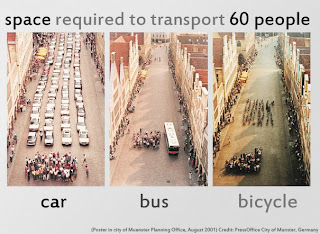First, what is the impact of ubiquitous ride-sharing on traffic in inner cities? Some research shows that as the cost of a car ride decreases, more people ride in cars who would otherwise have taken public transport or cycled.
The largest cost of a trip using a ride-sharing service is paying the driver. If self-driving cars are available, it seems obvious that a self-driving taxi or car hire service will be cheaper than one driven by a human. The effect will probably be more pronounced but of a similar nature to ride-sharing: taking traffic from public transport & cycling, but not reducing the number of cars on the road.
In addition to this I believe that Jevon's paradox may come into play here, as it has with storage space & compute capacity in the cloud. To quote Wikipedia, this 'occurs when technological progress increases the efficiency with which a resource is used (reducing the amount necessary for any one use), but the rate of consumption of that resource rises because of increasing demand.'
If rides become cheaper, then there is also the possibility that this will unlock demand by making previously uneconomical uses of ride-sharing viable, much like the falling price of coal which triggered the original paradox.
Parallel to this, each provider of ride-sharing has an incentive to provide as many cars, or potential rides, as possible. This is something we can see clearly in dockless bike-sharing, where competitors flood cities with their bikes in an effort to grab market share.
 |
| Ride-share bikes in China - Mashable |
For bike-sharing, surplus bikes can result in some very unusual scenes, such as the one shown here. For ride-sharing services, surplus cars would take up parking spaces, and increase congestion as they travel between rides.
The result is a 'tragedy of the commons' -type situation. The commons in this case is the common right of way (roads), and public parking spaces. The tragedy is that congestion could become so bad that the travel times become longer, and the impact on the environment is increased through the extra fuel consumption of what is for now overwhelmingly an ICE-based fleet of cars.
 |
| A famous advert for public transport, courtesy BoredPanda. |
Car-to-car coordination would, for example, enable fleet driving, where the driving of all cars in a fleet are slaved to the first, and drafting is used to reduce fuel consumption.
Fleet orchestration would enable many new ways of using cars, such as pre-placement of vehicles for surge periods, but the most important one for the environment would be optimising the distribution and direction of cars for maximum occupancy. This would be a super-charged version of UberPOOL.
Most congestion is caused by hundreds of cars with one person sitting inside each of them, something that in my opinion is the most insane sight that the average person will see, and ignore, on any given day. The problem is that this is a very hard problem to solve. Both these components would require extremely broad roll-out in order to be effective. However, they would also benefit from network effects: once a large provider has a version working well, it makes sense for additional cars to join their network if possible.
So to conclude: in my opinion, ride-sharing apps or self-driving cars cannot have a positive impact on the environment without full electrification and a major ramp-up in the intelligence with which fleets are deployed. Low-cost or autonomous car transport will lead to gridlock without coordinating intelligence, and worse pollution without full electrification.


